BURLINGTON, ON July 3, 2012 Lowville’s problem came to city council a little over a year ago. Things were getting out of control at the park and John Timmis wanted council to look into the problems and work with the community to find a solution.
The problem was – there were too many people using the park – at times there were groups numbering 500 people and the community felt their park wasn’t built to accommodate that number of people who were part of a single group.
The people of Lowville do things a little differently. They are settled along Guelph Line where there is a crook in the road with the Lowville Bistro dead ahead. Drive on into the grounds, hang a right and you are in the parking lot where parking is free and you can wander around to your hearts delight.
The people of Lowville tend to gather their almost every morning while they walk their pets and just get together to gab. They see this as their community park and while they are quite prepared to share the space and they don’t mind having to go in after a weekend and tidy up a bit – they think the park is being used for something it wasn’t built to do.
Lowville is part of rural Burlington and part of their affairs fall under the hand of Councillor John Taylor who knows just about all of the people in the community by first name.
The city decided the park needed some planning and after a bunch of meetings they got together in the old one room school house and talked through some ideas the residents had.
This was one of those situations where the ideas were coming from the community. The city hall staff weren’t on site to defend a report or a series of recommendations – they were their to listen to the ideas the residents had. And the residents had some pretty sensible ideas. While nothing had been costed out – the ideas looked as if they were well within a decent budget.
Councillor Taylor sat at the back of the room – he tends not to be a front and center guy. Staff were there to listen and ask questions.
Several days after the Lowville session Taylor took part in a Community Engagement Charter work shop where he heard about the need for the citizens of Burlington to organize themselves and have a Charter setting out their rights and what they could demand of the city.
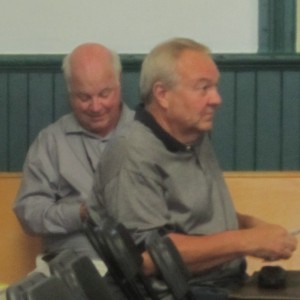
John Timmis, on the right, took community concerns about the Lowville Park to a city council committee meeting – sometime later the residents and city staff meet to work out a solution.
The folks in Lowville didn’t need a Charter – they just wanted a conversation – and that’s what they had. Lasted close to an hour and a half. No cookies or coffee – just steady back and forth, give and take, where Rob Peachey, Manager of Facilities, Parks & Open Space, addressed more than half the people by their first name. It was almost as if this was an extended family talking about changes they wanted to make to the way the family property was run.
The concerns the residents of Lowville had was not with people coming to the park – it was with the number of people and then with the way people behaved while they were there.
Anyone from Burlington can call city hall and request a permit to use one of the five permit spaces on a weekend. And that’s where part of the problem crops up. The city gets calls from someone who lives in Burlington requesting a permit which is for an association – and at times there are hundreds of people arriving.
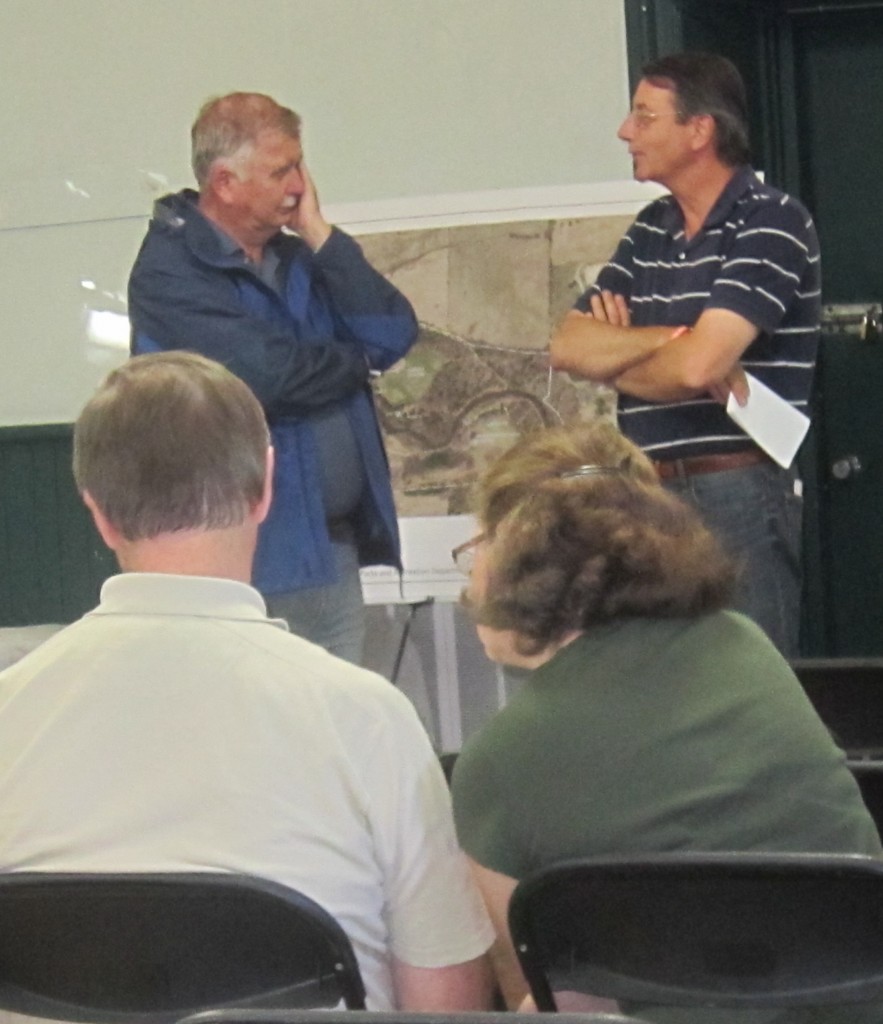
Lowville residents gather with city staff in a century old one room school house to talk through the problems they have with their local park .
The residents of Lowville saw their park as a place where families would gather in groups of maybe 40 or 50 and have a family picnic. But when the word got around that Lowville was a place that was inexpensive, the parking was free and the river running through the property was a great place for children to play and experience nature first hand, it became the location of choice for a lot of associations and companies who wanted to hold a staff picnic. It also became a place for very large groups that had no attachment to Burlington. The demand grew until it got out of hand.
The large crowds, some of whom brought along large blow up recreational devices and then power generators to keep them filled with air, was to the minds of the Lowville people, getting beyond a local park. They wanted city hall to put some boundaries in place.
The permit fee structure did allow for people who were not from Burlington. For the smaller parks the rate is $60 for residents and $120 for non-residents; for the large park the rate is $118. For residents and $237 for non-residents. The city determines who is a resident by the address they mail the permit to.
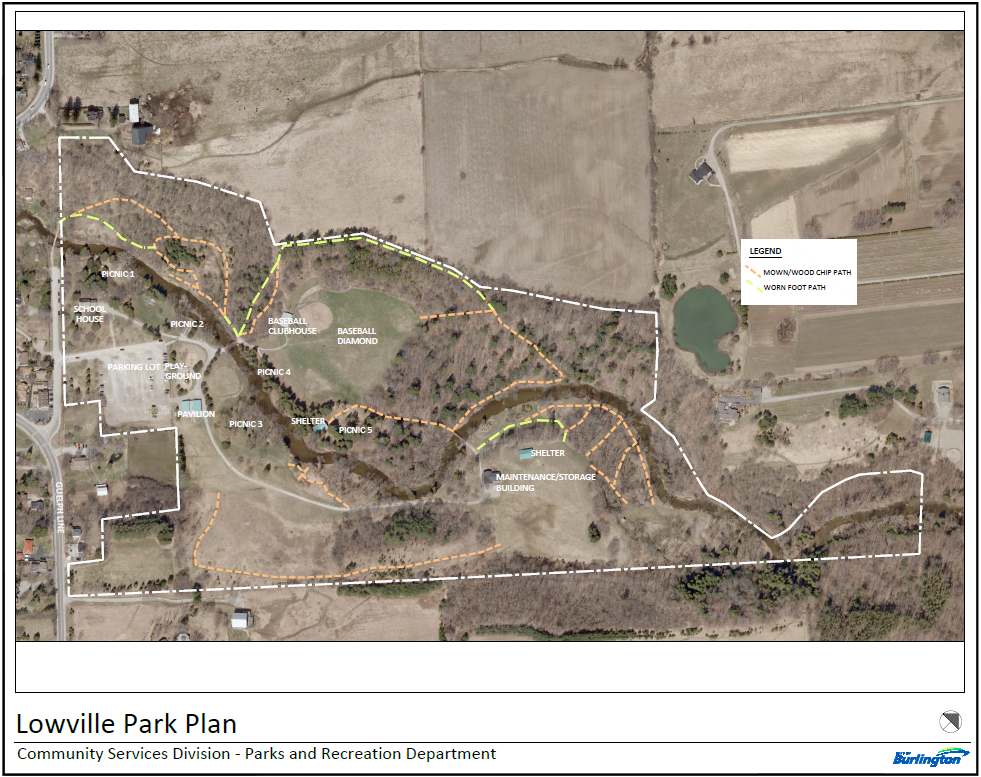
Lowville Park is one of those places where you can walk around for hours and just enjoy being out in the country. Picnic areas can be reserved, parking is free.
There are five permit areas in the park – that’s down from the seven that existed several years ago. Permit area 1 can handle up to 110 people, same for areas 2, 3 and 4. Permit area 5 can handle up to 250. When there are very large groups the city hands out two permits for two areas.
The large groups create parking problems and people began to park wherever they could find a space. The city brought in a towing truck recently and had it just sit there; that was certainly a deterrence but even with that parking tickets were handed out.
Companies get a permit and hold their staff picnic at the park and the residents don’t feel this is what the park was designed to accommodate. The residents believe that if they change the look and feel of the park that behaviour will change. The came up with some design changes that included putting trees in the parking lot area. That would make it seem less like a huge parking lot.
They want to build a small “island” at the entrance to the park that would have a large map of the grounds, some public notices and trees to soften the look of the roadway going in.
They didn’t want paved pathway; – use stone dust if you have to but no paving.
They want to see large areas of the back end of the park with grass that is not mown but left to grow naturally and create more of a natural sanctuary. Someone suggested changing the name to Lowville Natural Sanctuary – with the name telling people what the park was really about.
The residents felt the park was intended for smaller family gatherings – where there is space for 30 picnic areas that could accommodate 25-30 people at each. Scale is the concern for the Lowville residents. They just see a wonderful nature park with a stream running through much of it where the salmon spawn and where children can get a better understanding a nature in a real setting.
Large blow up toys with gas generators on hand to keep them filled with air is not what the community thinks the park is about and it certainly isn’t what they want. They see it as a natural environment and want to keep it that way.
There was no charter needed to make this meeting happen. Councillor Taylor sat in the corner of the one room school house and counted at least 30 solid votes in the audience. Citizen engagement at its best would have been his comment had you asked.
Part of the problem is that no one knows who has a permit and who doesn’t. There isn’t an attendant at a gate. People just drive in and go to where they think they are supposed to go.
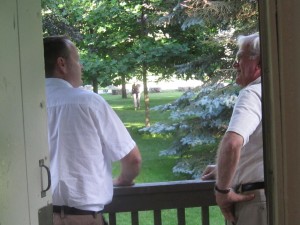
Rob Peachey, on the left, Manager Parks and Open Spaces for the city, talks through some solutions to managing the very large weekend crowds.
The city doesn’t want to put an attendant in without some offsetting revenue. Parking is free as is entrance to the park and the Lowville people want to keep it that way. They were opposed to charging for parking but they did want some control over the way the grounds are managed, particularly on the long weekends.
There was a point when the park had more than 1200 people on the grounds – with the reduction of two permit areas that capacity is down to 830 people which is about what the washrooms and the waste bins can handle.
The Lowville residents have the feeling that their community park is being overrun and put to a use for which it wasn’t designed. “This is a natural park but it has become a destination for large groups that want an inexpensive place to hold events for really large number of people.
The Lowville residents put their ideas up on a large map of the park with overlays showing the changes they thought made sense and then had a community discussion about the possible changes while city staff looked on. Staff then commented, asked some clarifying questions and it was a “we will be back to you in the fall.















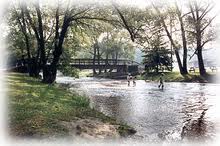

I’m pleased that the word Community has been used. I grew up in Lowville, and now my children spend many days, playing, exploring, and hopefully can continue to use this park for generations to come. It’s the only place in Burlington that I can say hasan’t become “commercialized”. Great job to the City for listening to the voices that live day to day in Lowville, and who continue to build, and make an effort to keep Lowville what it was in the past, and a a pleasure to visit.
Thank you for highlighting a community that is in tune with it’s roots and an issue that has been a concern for us. I commend Parks and Recreation for listening to those who use this park on a daily basis and whose lives would be deeply affected should we lose what this park has to offer to us.
I commend the residents of Lowville for standing up for their park. Wish we would do the same thing at Spencer Smith Park. The City seems to have forgotten how nice it would be to have a passive park that residents could enjoy as a quiet, peaceful refuge.